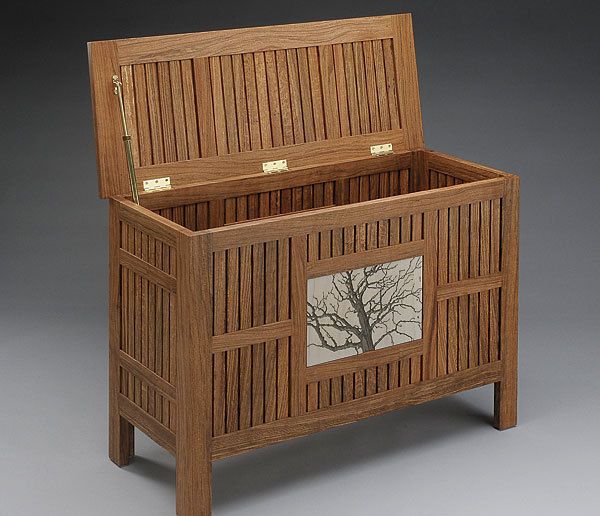
Synopsis: Using planks of red oak from a centuries-old tree that grew on George Washington’s estate, Mount Vernon, Duncan Gowdy built this chest for an exhibition of furniture made from trees with a historical pedigree. He got his inspiration from a corncrib on the estate, and carved the front panel depicting an old poplar tree, also at Washington’s home, on a piece of ash that had also grown there. The result is a chest that looks contemporary but can trace its lineage back to before the birth of the United States.
Several years ago I was lucky enough to receive some beautiful planks of red oak from a centuries-old tree that grew on the grounds of George Washington’s Mount Vernon estate. The wood came from William Jewell, who asked me to build something with it for an exhibition he was curating of furniture made from trees with a historical pedigree.
In search of inspiration for my design, I visited Mount Vernon. Having worked for a timber-frame builder in New Hampshire and spent time on my brother’s nearby farm, I have an affinity for farming and wooden farm structures, and after touring the house at Mt. Vernon I went directly to the agricultural area. I took dozens of photos of the gardens and structures there. The spark of inspiration I was seeking came from a corncrib, a small post-and-beam building that had an exposed framework of stout vertical timbers and an infill of vertical slats spaced apart for ventilation. I decided to adapt the idea for my blanket chest.
Most of my furniture incorporates carving, and when I build blanket chests I typically use a frame-and-panel structure with multiple panels on each face of the chest. This approach was inspired by Hadley chests, those heavily carved frame-and-panel pieces built between about 1680 and 1730 in the Connecticut River Valley—not far to the west of where I live in Massachusetts. On my pieces, though, rather than doing the sort of all-over carving found on Hadley chests, I limit the carving to one or more panels in the piece and leave the frame members unadorned. With this blanket chest, I decided to include just one carved panel and give the others visual interest by filling them with gapped slats.
My initial impulse was to have a large carved panel on the chest’s front that would be flanked by slatted panels of the same height. I sketched out the idea and then built a full-scale mockup. I built the mockup with 3⁄4-in.-thick oriented-strand board (OSB) sub-flooring, which, if not beautiful, is certainly cheap: It costs $16 or so for a 4×8 sheet. I pinned a sketch of the carving in place and used a marker to simulate the slats and splines. Standing back from the mockup, I was not pleased; my blanket chest was looking like a 1950s console television set.
I went back to the drawing board and changed the proportions, giving the piece more height, less ground clearance, and a little less length. I also reduced the size of the carving and designed a more complex framework of rails and stiles, introducing variation in the height of the slatted panels.
For the full article, download the PDF below.
Fine Woodworking Recommended Products

Dividers

Stanley Powerlock 16-ft. tape measure

Drafting Tools






















Log in or create an account to post a comment.
Sign up Log in